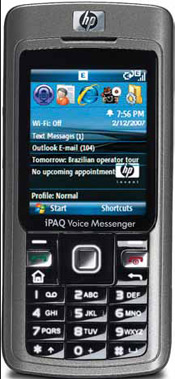
 |
Marios Ktisti, Commercial Product Manager at Hugh Symons Telecom takes a look at open source phone systems and the convergence of mobile phones.
Phone systems and mobile phones are continually evolving. The features of each and the integration of mobile phones and smartphones are increasingly on the agenda of the manufacturer, reseller and customer.
Therefore there are the main issues to consider – features, integration with mobile phones, what this means and what the costs are.
Normally buying a PBX is like buying a BMW – one starts off with the basic shell of the car and by the time the completed wish list has been met one has gulped quite a few mouthfuls of air. There are many add-on options in relation to features and the charges for the equipment, software and per user licences.
One then needs to look at a new method. The open source model is regarded by many as the way forward. Based on software called Asterisk these systems are feature rich and there are no licensing costs. The system will run on a server, Dell or HP for example and is scaleable – therefore the larger the concern the larger the server requirement.
As there are no licensing costs and the system is open source it means that the cost of the actual system itself is low.
The Asterisk system has been fine tuned by a global community of technicians with the result that it is very flexible – one is not limited by proprietary handsets for example. This flexibility allows more traditional telephony such as DECT phones or non-IP handsets to be connected to the system via the network with the simple addition of a telephone converter. Quite often customers will shy away from taking on a new system due to the sheer cost of the handsets themselves – so the option to convert existing handsets, although not unique, is still a potential olive branch to a prospective customer.
Conference at a Click
Conference at a Click “The ability to start a voice and video conference with instant messaging straight from your meeting in Outlook raises productivity and with regards to presence your status sets itself if you pick up the phone or if a meeting is booked in Outlook. In any case you make the rules – for example - divert to mobile when ‘Away’ and send to voice mail and email on ‘Do not disturb’.”
Cook believes that Microsoft’s position on unified communications is all about a single identity with which to communicate in the most efficient way.
“The real utopia being sought is ‘right click to call’. The OCS implementation we have developed for SpliceCom is simple, open and easy to use and for the relative cost it delivers a hell of a lot.
“We provide a range of bespoke software and network services. Primarily these solutions are based around internet technologies with the aim of enabling businesses to work smarter, improving communication and collaboration inhouse and externally with clients.
“Often business leaders have expressed concerns over their ability to manage their information effectively with their current systems and recognise that recent advances in internet technology have opened doors to new ways of doing business, the question they ask us is how?
“We have made a point of listening to and learning from our clients over the years to ensure we fully understand the business direction as well as the problems they are facing day-to-day, which in turn enables us to advise and educate them on the solutions that best fit their needs.
“There is a difference between day-to-day computing concerns and long-term value-added projects. It is important as a business leader to understand that a balance between them is required if the organisation is going to benefit from the valuable business tools that IT can provide. Valuable because they support traditional team working methods and give the transparency needed to ensure all staff are on the same page at times of strategic change.
“The impact on staff is one of the most important considerations in implementing IT systems. For most organisations technology is necessary but not sufficient...”
 |
the Wireless LAN Access Point and become part of the phone system. All outgoing calls are then handled by the phone system which will direct the call via the best route for the business, i.e the cheapest route. This method still allows the usage of the contacts on the phone and the ability to receive calls on the phones’ mobile number or via that person’s direct dial number attached to the phone system.
It also means from a cost perspective that users do not necessarily need to provide fieldbased staff with any desk phones when they are in the office. There are various figures mentioned but it has been suggested that 35- 40% of calls made by mobiles are made from one’s own office. In other words the opportunity for the reseller here is substantial.
It will be interesting to see how many more SIP integrated phones will appear in 2008. Nokia has recently added to the E60, E61i and the E65 with the addition of the E51 and clearly have a convergence policy in relation to this area:
“In today’s business world employees don’t just need a phone; they’re looking for tools, which can support all their communication needs. Nokia business devices have the potential to be delivered as part of a fully integrated mobile work solution. The SIPtrix IP PBX from Hugh Symons Telecom provides the ideal solution to incorporate the Nokia handsets in both fixed and mobile office environments” says Zoe Roberts Distribution Account Manager (Nokia).
In addition to Nokia, other manufacturers such as HP have already launched the iPAQ 514 smartphone that has integrated SIP. Nokia’s handsets can have the Intellisync client installed (Intellisync server also required), that provides the users with push email, PIM synchronisation and remote logistics for added security and device management.
The importance for the reseller in this area is to partner with somebody that can provide the missing skill sets. The one-dimension reseller needs to consider this going forward as more customers will demand more convergence between their phone system, their mobile phones and communication such as email with the benefits this brings in improving the productivity of the business in hand. When one adds to this the absence of licensing costs and ease of scaleability then this becomes very appealing to the business customer.
An open-source system such as SIPtrix is therefore an area to seriously consider for the forward-thinking reseller.
Ed Says
So, do you go with a proprietary or open source PBX? It’s a question being asked increasingly as well informed companies that need to replace aging phone systems weigh the alternatives in their move to IP telephony and VoIP.
If you look at the discussion groups and web sites on line you will see one of the key issues for Asterisk is that of user support – and where to get it. A company that downloads Asterisk code themselves and tries to set up a PBX because they can’t afford a traditional PBX is just the sort of company that should avoid open source. Remember TCO.
Hugh Symons Telecom however have all the support and applications issues well sorted for their resellers and has travelled down the ‘value-add’ for some time with their SIPTrix to ensure they have a stable, differentiated product. More importantly, companies such as Hugh Symons also have the mobility pedigree needed for mobile voice and data integration which means products and product support are there for resellers needing fixed mobile convergence applications for their customers.
Google IT:
Search Phrase Hits
‘Mitel Problems’ 7
‘Avaya Problems’ 17
‘Asterisk Problems’ 596
